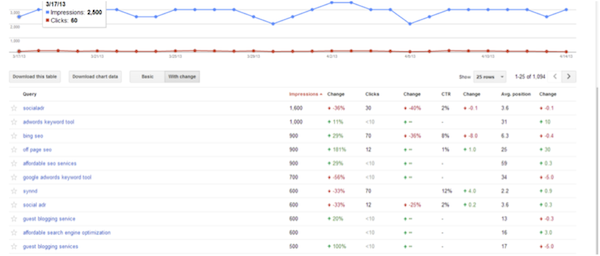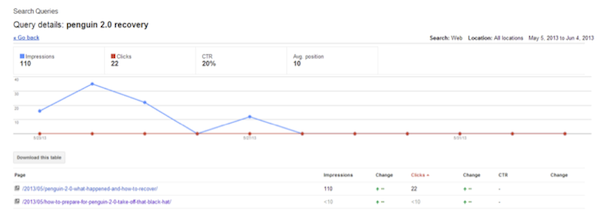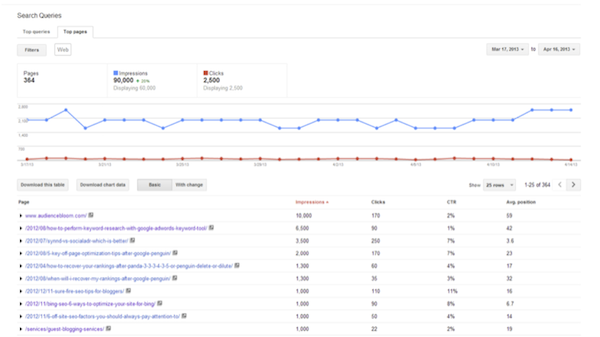
Google provides a number of tools for your SEO arsenal. The most obvious is Google Analytics, which offers an in-depth analytics suite to help even the most basic user understand and improve traffic to their website. But Google Webmaster Tools gives the advanced search expert another perspective on planning and evaluating his or her search efforts.
Here’s a closer look at how to use Google Webmaster Tools to get the most out of your SEO campaign.
Google Webmaster Tools: The Background
Google’s Webmaster Tools are essential for any strong SEO effort. To understand their full potential, it’s helpful to think about what Google Webmaster Tools‘ role is for webmasters: it helps you see your website as Google sees it. The toolset gives you insights into what pages have been indexed on your site, what links are pointing to it, your most popular keywords, and much more.
A site that’s active in Webmaster Tools has a better shot at being fully indexed and ranking well. There are also a number of deeper insights from Google Webmaster Tools can be turned into SEO tactical gold.
If you haven’t set your site up on Google Webmaster Tools yet, getting started is simple. Once you’ve signed up for an account, login to the Google Webmaster Tools dashboard. From there, you’re able to add your site.
You’ll have to first verify that you own the domain. Depending on your host, Google may provide verification through an easy pop-up process that allows you to login and verify in just a couple steps.
Other options include entering a Google-provided meta tag to your homepage, uploading an HTML file to your site’s root folder, or confirming ownership via Google Analytics if it’s already installed on your site. After you’ve verified your website, it’ll usually start populating data within 24 – 48 hours.
Google Webmaster Tools Features You Should Be Using
Once your site is set up, it’s time to log in and get to know the interface. If you need an introductory tutorial, here’s a good overview.
At its core, Google Webmaster Tools is all about metrics: what’s getting indexed, what’s getting linked, and what’s getting traffic.
Breaking down that data in different ways and looking at it with an eye toward learning specific things will help you make the most of the information. From this data, you can quickly formulate a plan around what next steps you need to take.
Get the Lay of the Land with Search Queries

The Search Queries area gives you both traffic and keyword information.
Why not just consult Google Analytics? Actually, Google Webmaster Tools gives a completely different (and possibly more holistic) view. It doesn’t just show you the breakdown of the traffic that made it to your site; it shows your traffic potential via impressions and site ranking across Google search results as well.
The Search Queries section is broken down into five main indicators:
- Query: Query gives you details on what keywords your site is currently ranked for. This is one of the fastest ways to decode whether your efforts to get on the map for a specific keyword are working. It’s important to remember that “rank for” means showing up in the SERPs – not necessarily actively attracting traffic (yet). This feature can help you quickly identify keywords that are relevant, but need a boost from linking or further content optimization.
- Impressions: If you’ve ever wondered how many people are seeing your website for a specific keyword search, this will tell you. This metric gives you a good sense of how many people are seeing specific sections of your content. This is another way to confirm the value of a keyword in addition to traffic data from the Google Keywords module and other tools.
- Clicks: Of the people who are seeing your site, how many are clicking? This information lets you know how many searchers seeing your site are taking action and clicking on your search result.
- CTR: Your CTR, or click-through rate, is the percentage of people that are clicking on your site in the search results. If your click-through rates are low, look at whether you can improve your meta description for that page. Can the content be made more relevant to the queries driving the most impressions for that page, or can you add a stronger call to action in the title tag or meta description? You should also consider the broader search landscape: is PPC activity driving traffic away from your branded results in the search, for example?
- Average Position: This metric tells you where your site typically ranks for each keyword. Since the vast majority of traffic goes to the sites in the top 2 positions for a given term, it’s helpful to see how you’re performing and the impact that has on your traffic.
Viewing Data With Change to See Trends Over Time

If you’ve recently launched a new SEO strategy and want to see how effective it is, one of the best ways to do that is to use the “With Change” feature. While you’re in the Search Queries section, activate the “With Change” button. This shifts the perspective and shows your current statistics as well as looking at your change in performance over time.
This data can be useful in a number of ways. Have you recently changed your site copy? If so, this can help to gauge the effectiveness of your updates. It’s also useful in the context of Google updates to see how your average rankings and conversions have been affected. Tracking this information over time is the best way to consistently adapt your SEO strategy to the broader SEO landscape.
Drilling Into Individual Keywords

To understand how you’re performing for an individual keyword, click on that term while you’re in the search query section. Diving into the data for individual keywords gives you insights on which pages are ranking for those words. Not only will this help you better understand your overall SEO successes, it specifically informs different elements of your content strategy.
It lets you know if content you’re developing is effectively targeting your selected terms. It also helps you identify connections you might not have perceived previously between existing content and target queries. Individual keywords with potential can also be given more focus when you’re developing new content such as blog posts, videos, and more.
Finding Optimization Opportunities with Top Pages

Within the “Search Queries” area, you’ll have the opportunity to see the “top pages.” This metric tells you which content on your site gets the most impressions and clicks. You can identify low-hanging fruit opportunities that are easy to capitalize on.
For example, if you have content that gets a great CTR but is ranking on Page 2 of the SERPs, you could build some links to that page in order to bump it to the first page. If you’ve been working hard to optimize content that’s not getting traction, you will often find other pages that are organically capturing visitors and can adjust your strategy. The key here is to understand that sometimes your audience focuses on something unexpected, and by uncovering that information you’re able to deliberately build your strategy to make the most of it.
Refining Your Page-Level Strategy

When you structured your site, you likely chose specific keywords to target with each page or section of content on your site. Google Webmaster Tools allows you to take that process in reverse, and identify what keywords each page of your content ranks for. Likely these will include both your target keywords and some surprises.
Once you’ve mapped out the keywords for each page, add those keywords to a rank tracking tool to find out additional data like traffic and competition. This will help you uncover any unexploited opportunities.
Once you get a list of what keywords a particular page ranks for, you should make sure your page actually contains all those keywords. Pay specific attention to high value real estate like your page titles and the first paragraph of your article.
Using Google Webmaster Tools Labs: Author Stats

Google’s Labs are where they test new features that are still being refined. Some will make it into the standard Google Webmaster Tools feature set, while others will fade away (like Site Performance). One popular option is the Author Stats information.
Author Stats allows you to tie in guest posts on other sites by connecting it to your Google + author account. Google Authorship is a major topic in the SEO world: it’s easily accomplished by “rel=author” tag that’s imbedded as a link in specific articles.
Your picture will appear next to content in the search engines, and it’s much easier for readers to find related material that you’ve written. It will also likely be used by Google in the future in the form of Author Rank.
“Author Stats” functionality can be used to identify the search statistics for your guest posts.
Up to now, it’s been hard to know what kind of traffic your posts on various sites get. This data can be a major input into your guest posting strategy. Now it’s possible to look quantitatively at not only which links are valuable, but how each posting is exposing your brand in a meaningful and scaled way.
Summary
When you’re developing an SEO strategy, consulting Google Webmaster Tools can give you a unique perspective. Diving into the data provides new opportunities to understand how your site is performing and help improve your overall campaign performance.
Are you using Google Webmaster Tools in other ways to support your SEO efforts? Let me know in the comments sections below!






